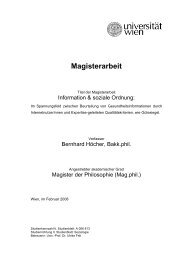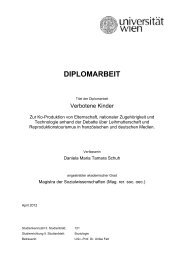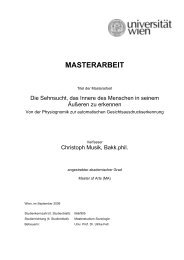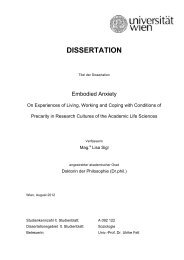MASTERARBEIT - Institut für Wissenschaftsforschung - Universität ...
MASTERARBEIT - Institut für Wissenschaftsforschung - Universität ...
MASTERARBEIT - Institut für Wissenschaftsforschung - Universität ...
Create successful ePaper yourself
Turn your PDF publications into a flip-book with our unique Google optimized e-Paper software.
LITERATURE & BACKGROUND INFORMATION<br />
Before digging deep into some detailed aspects of the development<br />
of Zeppelin’s airships, I believe it to be necessary - or at least very<br />
helpful - to provide a short introduction to the subject. As it will<br />
be explicated in chapter 3, my primary goal is not to unveil new<br />
facts about Zeppelin or his airship. Nor am I going to write the<br />
thousandth piece on the man or his invention - there is plenty of<br />
works covering those issues already. Instead, I want to use the story<br />
of how the zeppelins came into being as a case to showcase some STS<br />
concepts. While applying STS conceptions on it might also provide<br />
new insights into the developments around Zeppelin and his airship,<br />
my primary goal lies elsewhere: as mentioned in the introduction, the<br />
main focus is to give a thorough explanation of how different, mainly<br />
social, factors influenced the technology development and how the<br />
technology development fed back to those factors. Both SCOT and STI<br />
are going to provide new insights; as this perspective is apparently<br />
missing in the discourse so far, this structured approach is what I am<br />
trying to accomplish. Hence the historic part of this thesis stays with<br />
shared narratives: The history around Zeppelin and his technology<br />
given below are widely agreed on. It is the standard narrative that has<br />
formed over decades that the phenomenon has been re-examined by<br />
many and been told over and over again. The same is true for other<br />
historic accounts about the time and society the events I write about<br />
took place in. Here, too, I used available literature to draw a picture<br />
to illustrate my case, without arguing whether or not the common<br />
narratives about this time are authentic or not. Nevertheless, I find it<br />
necessary to introduce the reader to those narratives. As most likely<br />
not every reader is familiar with this particular part of history, I want<br />
to provide some background knowledge. Therefore, I will give a<br />
brief overview over the events that led to the development of airships<br />
by count Zeppelin on the following pages. Then, I will give some<br />
insights into the first steps of the technology development, which led<br />
to the point my analysis is going to focus on.<br />
Accounts about Count Zeppelin are virtually unanimous in respect<br />
to the most important points regarding the man, his life and his work.<br />
Almost all of them base widely on a biography by Hugo Eckener. [11]<br />
At least this holds true for those that are commonly referred to as<br />
sources for further writings about some facet of the zeppelin and<br />
that are encountered in virtually any bibliography of pieces about<br />
zeppelins. Eckener was a trained journalist, long lasting companion<br />
of count Zeppelin as well as his successor (who actually brought the<br />
7<br />
2







